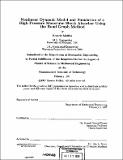Nonlinear dynamic model and simulation of a high pressure monotube shock absorber using the bond graph method
Author(s)
Mollica, Rosario
DownloadFull printable version (9.609Mb)
Advisor
Kamal Youcef-Toumi.
Terms of use
Metadata
Show full item recordAbstract
A physics-based model for a high pressure monotube shock absorber is proposed by which the nonlinear dynamic behavior of these dampers can be analyzed. The bond graph technique is used to model these shock absorbers accurately over a wide range of stroking frequencies and to identify the interaction between mechanical, fluid, and thermodynamic elements. Various phenomena are modelled such as fluid inertia effects, laminar orifice flow, air entrained in the hydraulic fluid, and cavitation. Simulation results demonstrate good model accuracy when compared t.o test data for similar hydraulic dampers. Parametric studies involving various elements of the system including gas pressurization, the amount of entrained air, and stiction are conducted in order to demonstrate the affects of these parameters on system performance. Results indicate the fundamental characteristics of shock absorbers are produced by the interaction of resistive and capacitive elements inherent in these systems. Capacitive elements combine with resistive elements resulting in hysteresis in the force-velocity characteristic and less energy dissipation at higher frequencies for constant maximum stroking velocities. The effects of fluid inertia and laminar flow are found to be negligible for the range of frequencies investigated ( 1 to 20Hz) in the monotube design of this study. Modifications to the model are proposed to reduce the state order for use in automotive suspension system models.
Description
Thesis (S.M.)--Massachusetts Institute of Technology, Dept. of Mechanical Engineering, 1997. Includes bibliographical references (p. 179-182).
Date issued
1997Department
Massachusetts Institute of Technology. Department of Mechanical EngineeringPublisher
Massachusetts Institute of Technology
Keywords
Mechanical Engineering